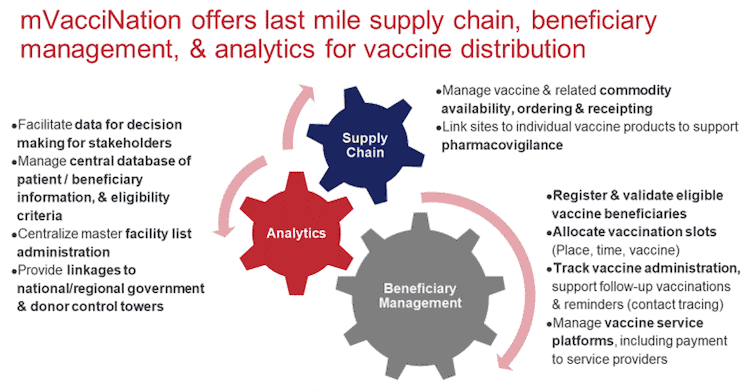[ad_1]

Introduction:
The pandemic has taught us a great deal. We have all become familiar with terms such as variants, waves, vaccine supply chains and quarantine.
It has also encouraged an interest in preventive health technology, especially in vaccines.
This interest is understandable, given that India accounts for the second highest caseload of COVID-19 globally.
Once the vaccines were available, the nation had to take on the task of rolling out one of the largest vaccination drives in the world; this of course, is not new to India.
Background of India’s Universal Immunization Programme (UIP):
India’s Universal Immunization Programme (UIP), launched in 1985 to deliver routine immunisation, showcased its strengths in managing large-scale vaccine delivery.
This programme targets close to 2.67 crore newborns and 2.9 crore pregnant women annually.
To strengthen the programme’s outcomes, in 2014, Mission Indradhanush was introduced to achieve full immunisation coverage of all children and pregnant women at a rapid pace — a commendable initiative.
But the pandemic reminded us that vaccines alone do not save lives, vaccination does.
While we have, over the years, set up a strong service delivery network, the pandemic showed us that there were weak links in the chain, especially in the cold chain, which needs to be robust and seamless.
Cold chain management:
The success of any sustainable vaccination programme relies on many factors.
- A key factor is cold chain management because when this fails, the potency or effectiveness of the vaccine is wasted.
- Nearly half the vaccines distributed around the world go to waste, in large part due to a failure to properly control storage temperatures.
- In India, close to 20% of temperature-sensitive healthcare products arrive damaged or degraded because of broken or insufficient cold chains, including a quarter of vaccines.
- Wastage has cost implications and can delay the achievement of immunization targets.
- Here, India has strong foundations to build upon. India’s UIP comprises upwards of 27,000 functional cold chain points of which 750 (3%) are located at the district level and above; the remaining 95% are located below the district level.
- The COVID-19 vaccination efforts relied on the cold chain infrastructure established under the UIP to cover 87 crore people with two doses of the vaccine and over 100 crores with at least a single dose.
- This effort was supported by the government’s cloud-based digital platform Co-WIN, which helps to facilitate registration, immunizations and appointments, and issues digital vaccine certificates, highlighting the benefits of digitization.
Digitizing the vaccine supply chain network:
- The Health Ministry has been digitizing the vaccine supply chain network in recent years through the use of cloud technology, such as with the Electronic Vaccine Intelligence Network (eVIN).
- Developed with support from Gavi, the Vaccine Alliance, and implemented by the UN Development Programme through a smartphone-based app, the platform digitizes information on vaccine stocks and temperatures across the country.
- This supports healthcare workers in the last mile in supervising and maintaining the efficiency of the vaccine cold chain.
- The role played by supportive infrastructure for cold chain such as a regular supply of electricity cannot be underplayed.
- In this regard, there is a need to improve electrification, especially in the last mile, for which the potential of solar-driven technology must be explored to integrate sustainable development.
- For instance, in Chhattisgarh, 72% of the functioning health centres have been solarized to tackle the issue of regular power outages.
- This has significantly reduced disruption in service provision and increased the uptake of services.
Building back better and stronger:
COVID-19, which disrupted supply chains across countries and in India too, marks an inflection point in the trajectory of immunization programmes.
As we recover from the pandemic, there is an opportunity for us to pivot to newer mechanisms that can help develop unbroken and resilient cold chain systems and thus augment the immunization landscape.
Going forward, this will be the only way to ensure access to the last mile with life-saving vaccines, in time.
The integrated solution combines:
Technology: Online real-time information on vaccine stocks and storage temperature to facilitate evidence-based decision-making.
Governance: Systemizing record keeping, upgrading logistics and encouraging good practices to ensure efficient vaccine logistics management.
Human Resources: To empower the state cold chain network by building the capacities of handlers and managers at each stage of vaccine supply.
Conclusion:
As we reflect on the learnings from the pandemic, it is imperative that we look towards a future where the critical arteries that comprise the supply chain of immunization facilities be strengthened.
India has pioneered many approaches to ensure access to public health services at a scale never seen before.
Robust cold chain systems are an investment in India’s future pandemic preparedness.
By taking steps towards actionable policies that improve the cold chain, we have an opportunity to lead the way in building back better and stronger.
[ad_2]

